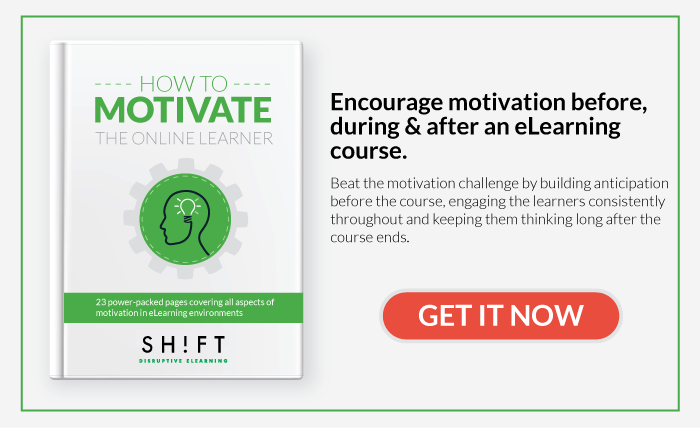Tom sits down to do his sales training online. He has been asked to complete three lessons each week adding up to 30 minutes of online training. Tom is dreading it, but he is delightfully surprised at how quickly he can navigate the page and how well the content has been paired with the graphics and features. He gets through 4.5 of the lessons and leaves the 5th lesson bookmarked for the next chance he gets.
Mary has been trying to find the lesson that the Fraud Department has assigned her. She has barely gotten passed lesson one in the time she had expected to complete at least 3. Her screen has frozen a few times on the graphics, she has had to re-read some of the text-heavy slides, and isn’t sure if the lesson she is on is going to help her with the issues she is meant to address.
Which of the two people mentioned above had a better UX Design experience with their eLearning course?
Who is going to continue with their eLearning course?
While engaging students and making sure content is entirely covered are critical parts of course success, it is just as important to make sure your user interface (UI) is intuitive, useful and easy to access. Taking the time to go through and check for great user experiences (UX) will help ensure that your students don’t lose out just because the course is difficult to navigate.
There must be a seamless flow between navigation/interface, the structure of content, multimedia, and graphic design to achieve a high-quality user experience. It leaves no rock unturned.
A pleasant experience with an eLearning course will facilitate and stimulate learning.
As you read on, think about the examples mentioned above and how each learner can be influenced by design factors.
Provided below are some essential questions to ask before starting out. Consider them as an essential guide to designing the best user experience in your eLearning course.

1- Is the eLearning course learner-centered? Is it usable?
High-quality UX design puts the learner at the heart of the design.
Always start asking this question: is your eLearning course usable? Can learners accomplish what they desire on the course without pulling out their hair?
Make sure you understand the needs of those learners who will engage with your course before start designing your course. Don't get caught with what “I” think my eLearning course should look like this! Embrace user testing and take your own course!
Take this test: Would You Take Your Own eLearning Course?
Evaluate each screen or step in every lesson. Has each been created with the learner in mind? The display/delivery of content is going to influence the student's take on it.
Why? Because design elements can enhance performance as it can direct them as well as ease any negative emotions or resistance to the learning experience.
- Evaluate if the structure is predictable and easy-to-use for the learner.What does each button represent? Is it intuitive? How do you go back? How do you move forward?
- Will the structure, titles, choice of icons, and content make sense to the learner? Pilot the course with a group of learners first to find out.
- Why has each element been included? Is this reason communicated to the learner?Every element on screen should have a purpose.
- Does every piece of the course help achieve the learning objectives?
Read more: 4 Steps to Becoming a Learner-Centered eLearning Professional
2- Is the experience engaging?
Aside from creating an user-friendly learning experience, believe it or not, one of the things to consider is how to get learners to complete the course. Without an instructor in the room, it is tricky to guide students, address questions, and force adults to complete a task.
This holistic presentation is why UX design for eLearning is so essential. Knowing how to introduce motivational triggers can encourage students to stay on the course and continue learning.
These are elements that will be essential to achieving this:
- Avoid ambiguity. It is essential to explain the objective to the learner, show them their progress, and to send reminders on where they have left off.
- Showing progress nudges learners to continue. Have the icons, graphics, and features that support and visualize the stated objective. Many instructional designers use visuals to show progress, sending a pie or bar chart encouraging them to come back and complete what’s left of the course.
- Visual design and interaction. You can provide great usability by incorporating things like effective interaction, powerful copy writing and clean presentation.
- Among many of the strategies available, consider asking each of these questions:
- Are the verbs in the instructions and buttons actionable and encouraging?
- Has an objective been stated and does everything support the learner achieving it?
- Can they measure their progress? Is there a follow-up them reminding them of progress? Think about Nintendo Games informing how close a gamer was to completing a level. It is addicting!
3- Is the experience the same on every device?
Responsive eLearning course is at the core to creating the best user experience in your eLearning course. If learners are open to taking a lesson on their device, on their own time, you don't want them to miss out or have a wrong impression of the experience! Every eLearning course you create should run smoothly on any device your learner may have.
Fundamental guidelines to evaluate responsive design with are:
- The course should adjust automatically to any screen.
- The course should be easy to access.
- There shouldn’t be an overload of text or graphics. Practice simplicity!
- Navigating should be as easy as if they were on their desktop.
Some questions to ensure an eLearning course meets the quality of the rules above are:
- Is the course loading quickly?
- Do the graphics look forced on the screen? Do they get in the way of the content?
Is there too much text? - Is the mobile version as intuitive as your desktop?
- If touch is an option for selection, have limiting tap/touch options created annoying selection problems?
4- How much is too much?
When it comes to eLearning, employees want a clean and well-organized interface so they can find what they need as quickly as possible without getting distracted.
If content feels cluttered, it will not be a smooth learning experience. Remember that learning is an emotional experience - adding too many visuals or text can overwhelm the learner and cause frustration. Instead, the course interface should give a sense of ease.
The learner should always intuitively understand what the main focus is on each screen. This guideline means that the screen should emphasize one main idea and one main action (Ex. advancing to next lesson) and very few alternatives (Ex., going back, returning “Home,” and so on).
Efficient use of white space and a clean layout can invite the learner in and help him/her enjoy the journey. If the course looks simple and straightforward, there is less to resist.
Here are some questions to help achieve an uncluttered interface:
- Go through each lesson. On each screen can the eye focus on what is most important?
- Does your graphic design help?
- Is the proportion of text and graphics accurate?
- Are they graphics aligned with the text?
- Is everything on each screen a “must?”
Read more: How To Avoid Designing Cluttered eLearning Screens
Going back to the example of Tom and Mary, UX design for eLearning courses is essential because it profoundly affects engagement. Your courses are not only crucial to learners as they educate many on their roles and growth in their careers, but also because businesses and teams have invested a great deal of time and energy to provide this to them and meet business objectives.
If the course is left behind, so is all this. Who is most likely to have continued to another lesson? Tom or Mary?
Of course, the answer is Tom. Integrating elements accurately, making it accessible on various platforms, and using the questions mentioned to guide the UX process will help create more Toms. It will be the first step for many to a long relationship with courses that can help advance your learner’s career as well as your business.


